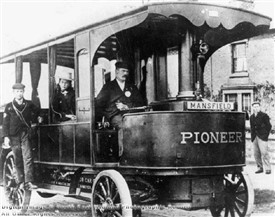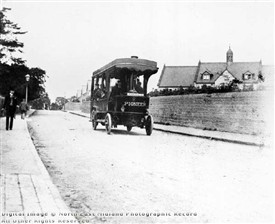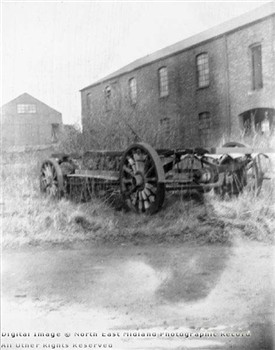Mansfield's Remarkable Steam Bus - PART 2

The Mansfield 'Pioneer' steam bus, photographed 30th June, 1898
The Old Mansfield Society and www.picturethepast.org.uk (NCCW000120)

In servce: The 'Pioneer' steam bus in action, photographed by A.S. Buxton
Mansfield Museum & Art Gallery and www.picturethepast.org.uk (NCCW001861)

A sad end: the chassis of the Mansfield steam bus, discarded and neglected. Photographed by A.S. Buxton in c.1900
Mansfield Museum & Art Gallery and www.picturethepast.org.uk (NCCW001861)
Arrival and Operation
In the closing years of the 19th Century, local concern over the lack of public transport to nearby villages, prompted some enterprising gentlemen in Mansfield to come up with a most ingenious plan.
Their project was to create a regular bus service employing an innovative steam-powered road car.
The Mansfield Advertiser newspaper of 22nd April 1898 (page 5) recorded the initiative as follows:-
"A number of gentlemen interested in the town have decided to take the question of railway facilities into their own hands to a certain extent, and to find means of getting about without either threatening or consulting the Midland Railway or any other company. The “Mansfield Motor Car Company, Limited,” with a nominal capital of £5,000, has now been floated, the object being to run motor cars from Mansfield to Pleasley, Sutton, Mansfield Woodhouse, Warsop, etc. The members forming the company include Messrs. W. J. Chadburn, G. A. Fish, F. Hameyer, C. Manners, F. A. Robinson, R. F. Vallance, and J. J. Ward. Communication between Mansfield and the surrounding villages is one of the great needs of the present. The company mean business, and are pushing forward the arrangements in a business-like spirit. Although their own interests will naturally be considered first, they will confer a great boon on the Borough by providing something which seems otherwise unattainable.
"It is anticipated that business will be commenced in about three weeks’ time. Only one car will be run at the outset, giving six services per day to Mansfield Woodhouse and three to the remaining villages, except on Saturdays. A proper time table will be drawn up, so that everybody will know exactly at what times the car will be available for travelling. Some experience of the needs of the villages will have to be gained before this can be completed, but it is suggested that the last car from Mansfield to Pleasley will leave at 10 o’clock, and 11 o’clock to Mansfield Woodhouse. On Wednesday afternoon it is proposed to run the car round the Dukeries.
"The fares to be charged work out at about one penny per mile. At present it is proposed to charge threepence between Mansfield and Pleasley, fourpence between Mansfield and Warsop, and threepence between Mansfield and Sutton. There will be penny stages between, and passengers can be taken or put down at any intermediate point. A single car will carry 22 passengers, and if the new means of locomotion “takes,” and there is no reason why it should not, another car will be added, making a total carrying capacity of 44 passengers. Of course the company are prepared to find cars to carry nine-tenths of the people should there be such a demand. The number depends entirely upon the extent to which the people use them. With a view to popularising them tradesmen have been offered a gross of penny tickets at 10s. per gross to accommodate their country customers. Already a quantity of these have been ordered.
"The car will be of the most modern construction. Steam will be the motive power, generated by petroleum. The wheels will be made of wood with steel rims, and with solid rubber tyres, so as to reduce the vibration to a minimum. There will be little noise, no smoke or hissing of steam. The engine will be a compound one, twenty-five horse power. Six miles per hour is the limit of the speed at which the “steam motor charabanc” with car attached can travel, and the charabanc itself eight miles an hour. Travelling will be altogether very comfortable, and with moderate fares, rapid transit, and regular service the motor car should soon be a great favourite in the district.
"It is intended to take up the question of heavy goods traffic as soon as possible.
"Shirebrook has been left out in the cold for the present, but the question of a decent direct road may have had much to do with this. Many people should be brought into the town from Warsop, because the car will pass by the people’s doors, while quite a journey has to be made to the East to West station. It is possible, too, that the people living at Sutton Forest Side might be induced to come into the Borough in preference to going to Sutton. The possibility of the people at Pleasley going a shopping to Sutton by the new Great Northern will practically be removed. From whatever point of view the new means of locomotion is looked at, it can easily be seen that it will be of great benefit to the town generally, and some of those whom it will most concern do not hesitate to give it their warm approval".
The website www.huthwaite-online.net provides the following information about the steam bus:-
Aptly christening their new steam powered motor bus owners quickly put 'The Pioneer' into regular working service commencing 1st July 1898. Fares were roughly a penny per mile along the daily passenger route between Warsop and Huthwaite. Other journeys along Nottingham Road and a long excursion into the Dukeries also proved successful, according to a report one week later describing it faultless and punctual while running some 50 to 60 miles daily without mishap. That was until return from a Horticulture Show on Saturday 22nd the same month. Official explanations claimed motor failure was caused by friction due to an oversight, suggesting tyres possibly even removed had given excessive vibration. A gentlemen's outfitter called Matthews & Sons took opportunity humorously placing an advertisement suggesting damage resulted from overloading, because so many of their customers had purchased sales garments. Their promotion offering payment for clients return fares did also predict quick repairs. Eventual rebuild claimed stronger replacement parts and the Pioneer recommenced services ending August, even though better rubber tyres had still not materialised. Further reports are yet to be found so it is presumed passenger service continued a little longer with fewer major problems.